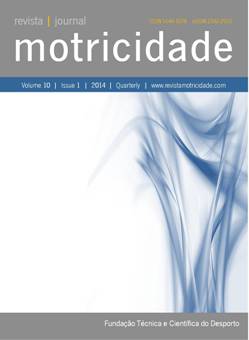Lateral preference and motor coordination
DOI:
https://doi.org/10.6063/motricidade.1245Abstract
The aim of this study was to evaluate the effect of hand and foot preferences, sex and age on motor coordination (MC) in children. We evaluated the hand preference (HP) through the Card-reaching task (Carlier et al., 2006, adapted from Bishop et al., 1996) and the Dutch Handedness Questionnaire (Van Strien, 2002). Foot preference (FP) was evaluated inviting the subjects to kicking a ball (Hart & Gabbard, 1996). We applied the Movement Assessment Battery for Children MC test (Henderson & Sugden, 1992) to 319 children (7.96 ± 2.38 y). The results show that right handers have better performance on manual dexterity (MD) and ball skills (BS) with their preferred hand (PH). Left-handers perform better with their non-preferred hand (NPH) in MD and have a better static balance (SB) with your non-preferred foot (NPF). Girls had better MD with NPH and better SB with NPF. We observed a better MD performance with PH and NPH, BS with NPH and SB with the PF and NPF in the younger children. PH×Age and Mp×Age×Sex interactions were also verified. It can be concluded that the laterality, sex and age have significant effects on children MC.
Downloads
Published
Issue
Section
License
The authors of submitted manuscripts must transfer the full copyright to Journal Motricidade / Desafio Singular Editions. Granting copyright permission allows the publication and dissemination of the article in printed or electronic formats and copyrights start at the moment the manuscript is accepted for publication. It also allows Journal Motricidade to use and commercialize the article in terms of licensing, lending or selling its content to indexation/abstracts databases and other entities.
According to the terms of the Creative Commons licence, authors may reproduce a reasonable number of copies for personal or professional purpose but without any economic gains. SHERPA/RoMEO allows authors to post a final digital copy (post-printing version) of the article in their websites or on their institutions' scientific repository.


